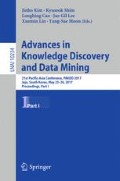Abstract
If Alice is majoring in Computer Science, can we guess the major of her friend Bob? Even harder, can we determine Bob’s age or sexual orientation? Attributed graphs are ubiquitous, occurring in a wide variety of domains; yet there is limited literature on the study of the interplay between the attributes associated to nodes and edges connecting them. Our work bridges this gap by addressing the following questions: Given the network structure, (i) which attributes and (ii) which pairs of attributes show correlation? Prior work has focused on the first part, under the name of assortativity (closely related to homophily). In this paper, we propose ProNe, the first measure to handle pairs of attributes (e.g., major and age). The proposed ProNe is (a) thorough, handling both homophily and heterophily (b) general, quantifying correlation of a single attribute or a pair of attributes (c) consistent, yielding a zero score in the absence of any structural correlation. Furthermore, ProNe can be computed fast in time linear in the network size and is highly useful, with applications in data imputation, marketing, personalization and privacy protection.
Access this chapter
Tax calculation will be finalised at checkout
Purchases are for personal use only
Notes
- 1.
f is superadditive \( \iff f(x+y) \ge f(x)+f(y)\).
References
Akcora, C.G., Carminati, B., Ferrari, E.: User similarities on social networks. Soc. Netw. Anal. Min. 1–21 (2013)
Akoglu, L., Faloutsos, C.: RTG: a recursive realistic graph generator using random typing. Data Min. Knowl. Disc. 19(2), 194–209 (2009)
Albert, R., Barabási, A.L.: Statistical mechanics of complex networks. Rev. Mod. Phys. 74(1), 47 (2002)
Bianconi, G.: Interdisciplinary and physics challenges of network theory. EPL (Europhys. Lett.) 111(5), 56001 (2015)
Boccaletti, S., Latora, V., Moreno, Y., Chavez, M., Hwang, D.U.: Complex networks: structure and dynamics. Phys. Rep. 424(4), 175–308 (2006)
Bothorel, C., Cruz, J.D., Magnani, M., Micenkova, B.: Clustering attributed graphs: models, measures and methods. Netw. Sci. 3(03), 408–444 (2015)
Choudhury, M.D., Counts, S., Horvitz, E., Hoff, A.: Characterizing and predicting postpartum depression from shared Facebook data. In: CSCW (2014)
Colombo, G., Burnap, P., Hodorog, A., Scourfield, J.: Analysing the connectivity and communication of suicidal users on Twitter. Comput. Commun. 73, 291–300 (2016)
Crandall, D., Cosley, D., Huttenlocher, D., Kleinberg, J., Suri, S.: Feedback effects between similarity and social influence in online communities. In: Proceedings of 14th ACM SIGKDD International Conference on Knowledge Discovery and Data Mining, pp. 160–168 (2008)
Gong, N.Z., Talwalkar, A., Mackey, L., Huang, L., Shin, E.C.R., Stefanov, E., Shi, E.R., Song, D.: Joint link prediction and attribute inference using a social-attribute network. ACM Trans. Intell. Syst. Technol. (TIST) 5(2), 27 (2014)
Gong, N.Z., Talwalkar, A., Mackey, L., Huang, L., Shin, E.C.R., Stefanov, E., Song, D., et al.: Jointly predicting links and inferring attributes using a social-attribute network (SAN) (2011). arXiv preprint arXiv:1112.3265
Gong, N.Z., Xu, W., Huang, L., Mittal, P., Stefanov, E., Sekar, V., Song, D.: Evolution of social-attribute networks: measurements, modeling, and implications using Google+. In: Proceedings of 2012 ACM Conference on Internet Measurement Conference, pp. 131–144 (2012)
Kim, M., Leskovec, J.: Multiplicative attribute graph model of real-world networks. In: Kumar, R., Sivakumar, D. (eds.) WAW 2010. LNCS, vol. 6516, pp. 62–73. Springer, Heidelberg (2010). doi:10.1007/978-3-642-18009-5_7
La Fond, T., Neville, J.: Randomization tests for distinguishing social influence and homophily effects. In: Proceedings of 19th International Conference on World Wide Web, pp. 601–610. ACM (2010)
Lewis, K., Gonzalez, M., Kaufman, J.: Social selection and peer influence in an online social network. Proc. Natl. Acad. Sci. 109(1), 68–72 (2012)
Newman, M.: Networks: An Introduction. Oxford University Press, Inc., Oxford (2010)
Newman, M.E.: Mixing patterns in networks. Phys. Rev. E 67(2), 026126 (2003)
Pelechrinis, K., Wei, D.: VA-index: quantifying assortativity patterns in networks with multidimensional nodal attributes. PLoS ONE 11(1), e0146188 (2016)
Pfeiffer III, J.J., Moreno, S., La Fond, T., Neville, J., Gallagher, B.: Attributed graph models: modeling network structure with correlated attributes. In: Proceedings of 23rd International Conference on World Wide Web, pp. 831–842. ACM (2014)
Rabbany, R., Zaïane, O.: Generalization of clustering agreements and distances for overlapping clusters and network communities. Data Min. Knowl. Disc. 29(5), 1458–1485 (2015)
Silva, A., Meira, W., Zaki, M.J.: Mining attribute-structure correlated patterns in large attributed graphs. Proc. VLDB Endow. 5(5), 466–477 (2012)
Traud, A.L., Mucha, P.J., Porter, M.A.: Social structure of Facebook networks. Physica A 391(16), 4165–4180 (2012)
Wang, P., Xu, B., Wu, Y., Zhou, X.: Link prediction in social networks: the state-of-the-art. Sci. China Inf. Sci. 58(1), 1–38 (2015)
Yin, Z., Gupta, M., Weninger, T., Han, J.: LINKREC: a unified framework for link recommendation with user attributes and graph structure. In: Proceedings of 19th International Conference on World Wide Web, pp. 1211–1212. ACM (2010)
Author information
Authors and Affiliations
Corresponding author
Editor information
Editors and Affiliations
Rights and permissions
Copyright information
© 2017 Springer International Publishing AG
About this paper
Cite this paper
Rabbany, R., Eswaran, D., Dubrawski, A.W., Faloutsos, C. (2017). Beyond Assortativity: Proclivity Index for Attributed Networks (ProNe). In: Kim, J., Shim, K., Cao, L., Lee, JG., Lin, X., Moon, YS. (eds) Advances in Knowledge Discovery and Data Mining. PAKDD 2017. Lecture Notes in Computer Science(), vol 10234. Springer, Cham. https://doi.org/10.1007/978-3-319-57454-7_18
Download citation
DOI: https://doi.org/10.1007/978-3-319-57454-7_18
Published:
Publisher Name: Springer, Cham
Print ISBN: 978-3-319-57453-0
Online ISBN: 978-3-319-57454-7
eBook Packages: Computer ScienceComputer Science (R0)

